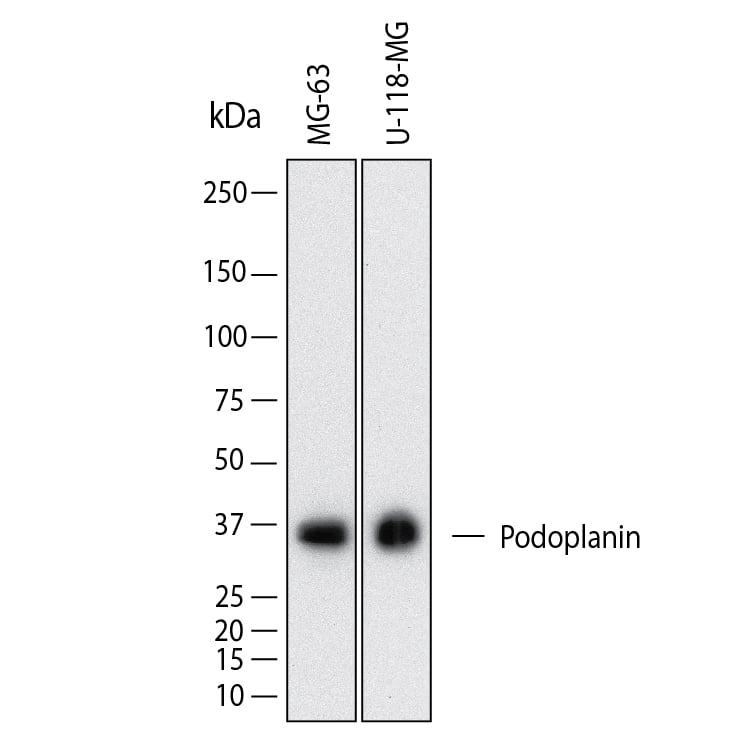Human Podoplanin Antibody
R&D Systems, part of Bio-Techne | Catalog # AF3670


Key Product Details
Species Reactivity
Validated:
Cited:
Applications
Validated:
Cited:
Label
Antibody Source
Product Specifications
Immunogen
Glu21-Lys123
Accession # Q86YL7
Specificity
Clonality
Host
Isotype
Scientific Data Images for Human Podoplanin Antibody
Detection of Human Podoplanin by Western Blot.
Western Blot shows lysates of MG-63 human osteosarcoma cell line and U-118-MG human glioblastoma/astrocytoma cell line. PVDF membrane was probed with 1 µg/ml of Sheep Anti-Human Podoplanin Antigen Affinity-purified Polyclonal Antibody (Catalog # AF3670) followed by HRP-conjugated Anti-Sheep IgG Secondary Antibody (Catalog # HAF016). A specific band was detected for Podoplanin at approximately 36 kDa (as indicated). This experiment was conducted under reducing conditions and using Western Blot Buffer Group 1.Podoplanin in Human Uterus.
Podoplanin was detected in immersion fixed paraffin-embedded sections of human uterus using 2 µg/mL Sheep Anti-Human Podoplanin Antigen Affinity-purified Polyclonal Antibody (Catalog # AF3670) overnight at 4 °C. Tissue was stained with the Anti-Sheep HRP-DAB Cell & Tissue Staining Kit (brown; CTS019) and counterstained with hematoxylin (blue). View our protocol for Chromogenic IHC Staining of Paraffin-embedded Tissue Sections.Applications for Human Podoplanin Antibody
CyTOF-ready
Flow Cytometry
Sample: A431 human epithelial carcinoma cell line
Immunohistochemistry
Sample: Immersion fixed paraffin-embedded sections of human uterus
Western Blot
Sample: MG-63 human osteosarcoma cell line and U-118-MG human glioblastoma/astrocytoma cell line
Reviewed Applications
Read 3 reviews rated 4 using AF3670 in the following applications:
Formulation, Preparation, and Storage
Purification
Reconstitution
Formulation
*Small pack size (-SP) is supplied either lyophilized or as a 0.2 µm filtered solution in PBS.
Shipping
Stability & Storage
- 12 months from date of receipt, -20 to -70 °C as supplied.
- 1 month, 2 to 8 °C under sterile conditions after reconstitution.
- 6 months, -20 to -70 °C under sterile conditions after reconstitution.
Background: Podoplanin
Podoplanin, also known as glycoprotein 36 (gp36), PA2.26 antigen, T1-alpha (T1A), and aggrus, is a 36 kDa type I transmembrane sialoglycoprotein and member of the Podoplanin family (1‑2). Podoplanin has three potential splice variants, the longest of which is represented by a 238 amino acid (aa) precursor (NP_006465). It contains an undefined signal sequence, a 22 aa transmembrane segment (aa 207‑228) and a short cytoplasmic tail (aa 229‑238). The ECD contains abundant Ser/Thr residues that could serve as potential O-linked glycosolation sites. The cytoplasmic tail contains putative sites for protein kinase C phosphorylation (2‑3). There are two potential alternate start sites at Met 77 (Swiss Prot #: Q86YL7) and Met 119 (EAW51692) that generate short forms. The 162 aa short form Podoplanin precursor shares 47% aa identity with mouse Podoplanin. Podoplanin is expressed on glomerular epithelial cells (podocytes), type I lung alveolar cells, lymphatic endothelial cells (4‑5), and numerous tumors, including colorectal tumors (3), squamous cell carcinomas (4, 6), testicular seminoma (7), and brain tumors (8‑10). One study shows high expression of Podoplanin mRNA in placenta, lung, skeletal muscle, and heart, and weaker levels in brain, kidney, and liver (1). Podoplanin is the ligand for C-type lectin-like receptor 2 (CLEC-2) (2). Their association is dependent on sialic acid on O-glycans of Podoplanin (2). Through its association with CLEC-2, Podoplanin induces platelet aggregation and tumor metastasis (2). Podoplanin is also necessary for lymphatic vessel formation, normal lung cell proliferation and alveolus formation at birth (2).
References
- Zimmer, G. et al. (1999) Biochem. J. 341:277.
- Katsue-Inoue, K. et al. (2007) J. Biol. Chem. 282:25993.
- Kato, Y. et al. (2003) J. Biol. Chem. 278:51599.
- Schacht, V. et al. (2005) Am. J. Pathol. 166:913.
- Breiteneder-Geleff, S. et al. (1997) Am. J. Pathol. 151:1141.
- Kato, Y. et al. (2005) Tumour Biol. 26:195.
- Kato, Y. et al. (2004) Oncogene 23:8552.
- Mishima, K. et al. (2006) Acta Neuropathol. 111:563.
- Mishima, K. et al. (2006) Acta Neuropathol. 111:483.
- Kato, Y. et al. (2006) Biochem. Biophys. Res. Commun. 349:1301.
Long Name
Alternate Names
Gene Symbol
UniProt
Additional Podoplanin Products
Product Documents for Human Podoplanin Antibody
Product Specific Notices for Human Podoplanin Antibody
For research use only
